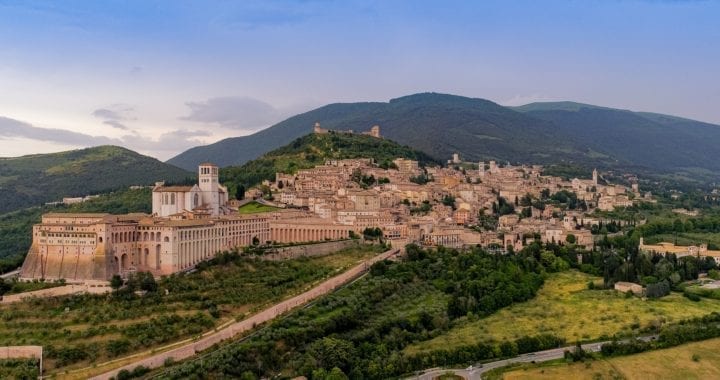During this visit to Assisi, my favorite Italian hilltown, I was serving as guide to a group of my students. If you have ever wanted to know what Assisi feels like, I hope this gives some small sense of its wonder.
Five or so vertiginous days into a whirlwind tour of Italy, my students, my mother, my son, and I arrive with our discordant tour group at the base of Monte Subasio. This trip is not what I had planned. Nothing like my personal vacations to my favorite European country. Disappointing, to be brutally honest: delayed and rerouted flights, seemingly endless hours in an unexpected coach bus, disrespectful factions of scantily-clad teens who had clearly not researched the cultural norms or, worse, didn’t care. And here I stand lifting my face to Assisi, the home of Saint Francis, where, on my last visit, I discovered one of the most beautiful, tranquil places on Earth. As we proceed en masse up the breathtaking hillside, my heart is hopeful that I will be able to sort out a shred of peace in the midst of this holy mess.
Silvery slivers of olive leaves shimmer hazily in carefully pruned groves. Tall, thin evergreens reach to the Umbrian sun in neatly planted rows. Umbrella trees with trunks stretch to the sky, then explode into plateaus of greenery. The Italian countryside is a painting so beautiful it can’t possibly be real. Standing atop the walled piazza adjoining La Basilica di Santa Chiara, I take in the expanse of Italian landscape rolling forth from the foothills of Assisi, where hues of brown and green fade into and slip out of one another, pale-bricked buildings grouped here and there about the idyllic countryside.
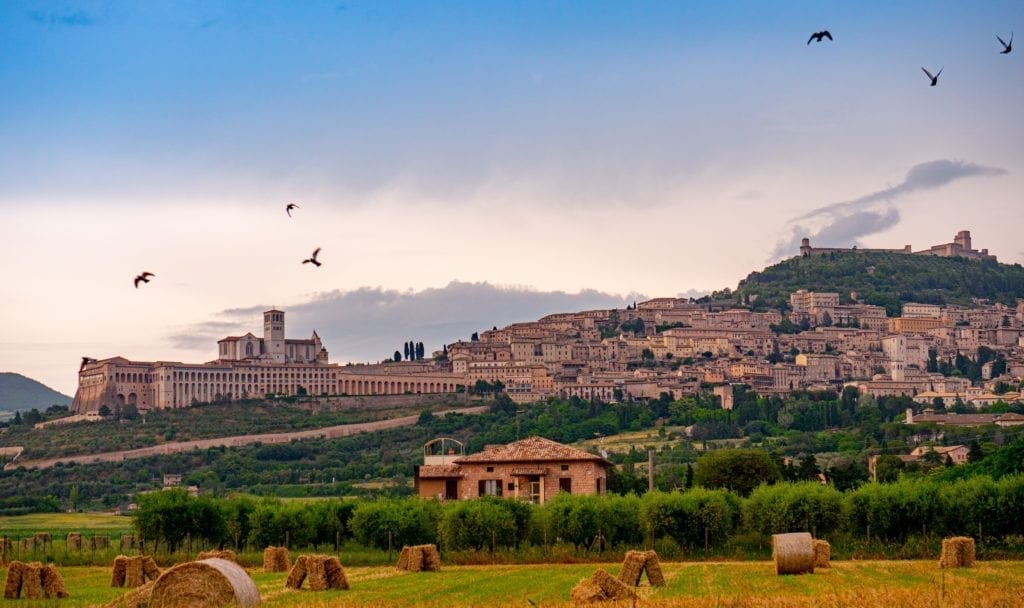
Cattedrale di San Rufino at the pinnacle on the right
Assisi is a hill-town rising from Monte Subasio on the eastern agricultural plains of Italy’s only landlocked regionale. I cannot help but be awed by both its beauty and majesty, and my students, too, try to intellectualize the ancient allure surrounding them. Blanketing its green hill like a cream-colored diamond, Assisi spreads widely from side to side, crowned colossally at its pinnacle by Rocha Maggiore, a medieval castle effectively designed to intimidate the masses. Santa Chiara centers the diamond, and La Basilica di San Francesco, the beautiful chiesa protecting the remains of Saint Francis, patron saint of animals and the environment, dominates the left expanse of Assisi, where the Basilica’s three levels are massively one with the hillside.
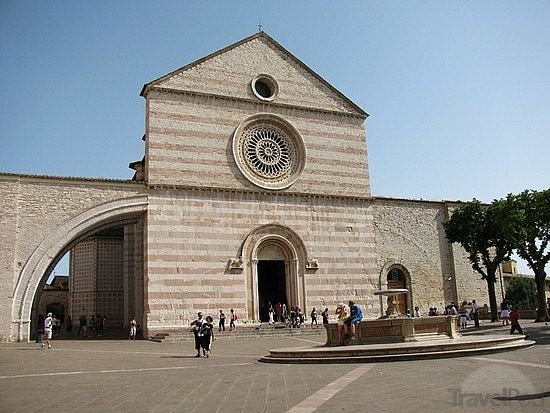
Leading up and away from Santa Chiara, a narrow street lined with olive wood shops, tourist vendors, and gelato counters leads to the main Piazza del Commune, where groups of tourists cluster around tour directors holding extension poles topped with brightly-colored flags, stuffed animals, and scarves to distinguish one from another. Locals relax in small groups over cups of cappuccino, watching and often laughing at the daily spectacle of wide-eyed, scantily-clad, noisy stranieri, strangers who come from Germany, Asia, and America to see the tour book pictures of Rocha Maggiore and the Cattedrale di San Rufino, Assisi’s Duomo, come to life.
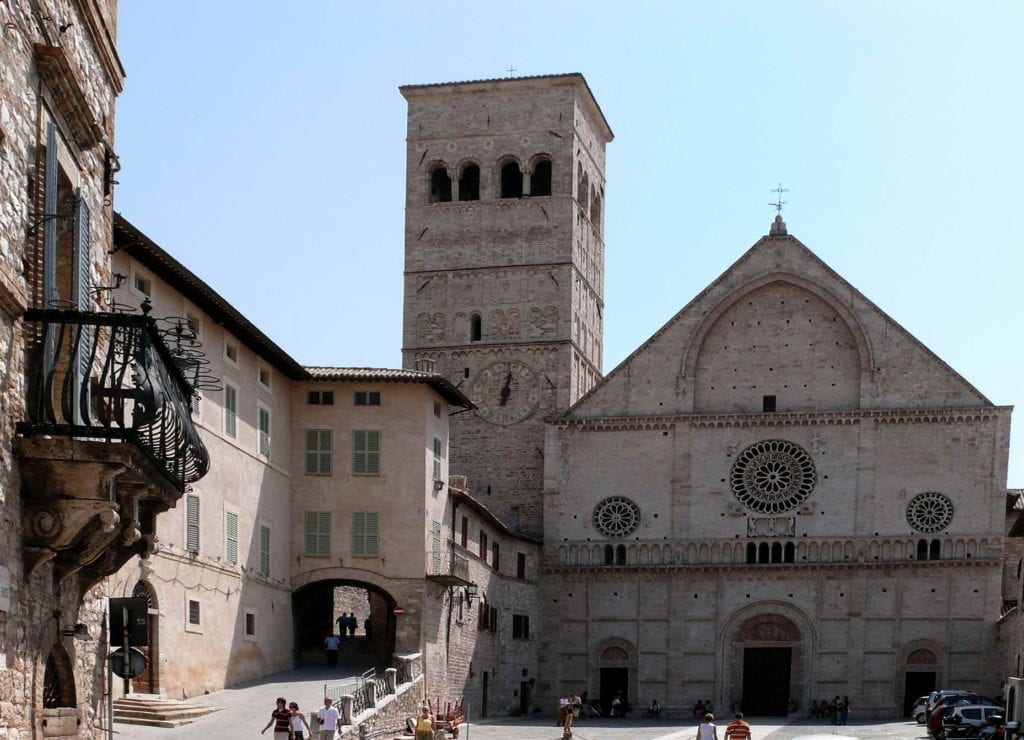
The Communal Square is laid out in a long rectangle with cobblestone streets leading up or down from each corner, and narrow stone walkways receding away from each side. On one length, the strong pillars of what was once a Temple to Minerva reach loftily to the bright summer sun, preserved because the temple, like so many other originally pagan structures, was taken over and then protected by the Christians who converted them into chiese – churches dedicated to the Christian God, Trinity, and saints. On the other sides of the town square, ancient buildings have been turned into minor museums, a bank, and tiny, narrow shops well-packed with wares.
I have returned to Assisi to absorb the spiritual splendor of La Basilica di San Francesco. Though I am not Catholic, the life and work of Francis, especially his relationship with and philosophies regarding nature, are an inspiration to me. I have come here seeking peace. Crossing the Piazza, I take the cobblestone road leading down and away from the central square, where I duck into a shop with a showcase of olive wood crafts and select a handful of Tau necklaces to take back to friends. I love the story behind the Tau: a “broken” cross that Francis, as a “broken man,” claimed as his own. Carved from Olive wood, oiled, and slung on thin leather necklaces, the trinkets resonate with the echos of the natural world that was so important to Francis.
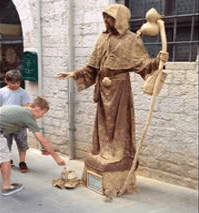
Continuing down the road between buildings so high they block out the midday sun, I pause to admire the silkwork in a selection of Italian scarves, but I check my cell phone and, pressed for time, I move on. I do take a few moments to step into a shoe store that I know offers high-quality leather shoes, and I efficiently choose a pair of decently-priced Birkenstocks, size 40 – an American woman purchasing German sandals in an Italian hill-town. Around a small curve in the road, I notice a crowd at the side and, drawing closer, I see a street performer dressed in the garb of a Franciscan monk, poised perfectly still. He is painted head to toe, including his regalia, in the many cream-colored shades of a stone statue, his right hand raised in the posture of a blessing, his left hand resting on a tall, cream-painted walking staff. Curious, I pause to see a woman in shorts and a bright pink tank top approach and drop a Euro in a cream-colored box at his feet. Like a wind-up toy, the performer comes to life, reaching out with his right hand to perform a sign of blessing toward the woman and almost touching her forehead. Then he bends slightly and reaches smoothly into a satchel on his left side to pull out a white card to hand to her, a blessing of Saint Francis printed on it as a small token. He resumes his posture and freezes.
I continue through a tall stone archway, and passing a handful of monks from each of the three Franciscan orders, a few nuns, and even more tourists, I descend the road that I know will lead me to San Francesco. A sense of longing draws me toward it. I know, as part of this tour group, that I will not have the time I want to simply sit and bask in the dense spirituality of the place, but I push that regret aside and draw into myself the pace -peace- that is the essence of Francis’s legacy. Saint Francis would want me to.
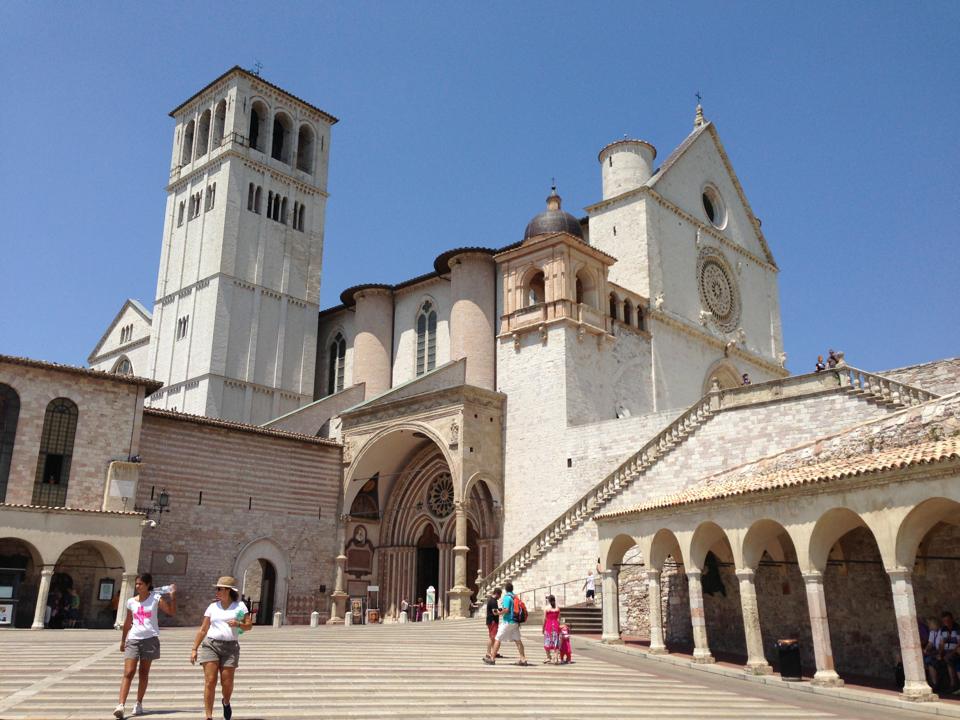
The Basilica itself rises from the very edge of Assisi, its cloister and foundations invisible from here above, but massive in length and height as viewed from the plains. The upper Basilica houses the famed frescoes of Giotto –the same artist who designed and began the Campanile of Florence’s renowned Duomo – telling the story of Francis’s life, work, and miracles. The lower Basilica is still used for masses and is characterized, as typical in many basilicas, by small chapels that line the side of the nave, beautiful statues, paintings, and memorials decorating each to honor the saints and the memories of the deceased. Descending below the lower basilica, the faithful (as well as the tourists) can visit, rest, or pray in the presence of the relics of Saint Francis – the holy saint’s remains entombed in a small stone box in a center glass column protected by an ornate, black, iron cage.
This is why I have come. But those who are with me are not so faithful, and the throngs of tourists are distracting, pushy, and noisy. The pace I seek will not easily be found here, simply because I cannot remove myself from my students to seek it. So, as slowly as reasonable, I circle the glass column and strive to focus my thoughts on the beauty and awe of where I am, separating as much as possible the rude noisiness of those who cannot translate the signs demanding “silencio / ‘silence’” and the inner calm I want to engender. It flickers long enough for me to know where I am, and the crowd moves on.
I will return to Assisi. I must. The Italian countryside – Umbria and, also, Tuscany – calls to me. When I am there, time stops. When I am there alone, my world feels as it should be.
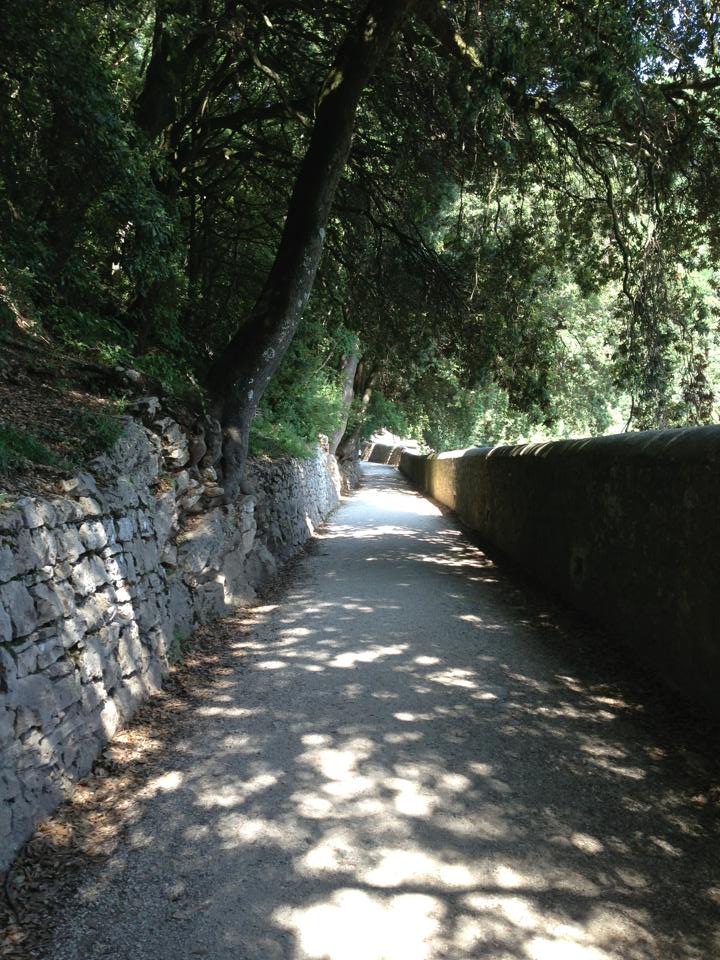
Very near the famed hill-town, near enough that Francis walked there with his followers, the Eremo di Carceri is ensconced in the valleys of the Monte Subasio ridges. The forest there reminds me much of our own Ozarks – the trees, the undergrowth, and the birdsong all feel the same. There aren’t as many tourists here, as it takes time and more effort than most modern visitors are willing to give to climb the mountain to arrive at this Hermitage where Francis went to escape the world and to reconnect with God and nature. Paths wind up and around hills. The ‘cave’ where he slept is but a person-sized niche at the side of the path. The beauty of the place is indescribable. Here, I, too, find that I can reconnect with God and nature. Here, I too can find peace.
For information about Italy or a uniquely crafted, personalized itinerary, contact Kimberly at (816) 866-8883 or Kimberly@NextAdventureVacations.com

